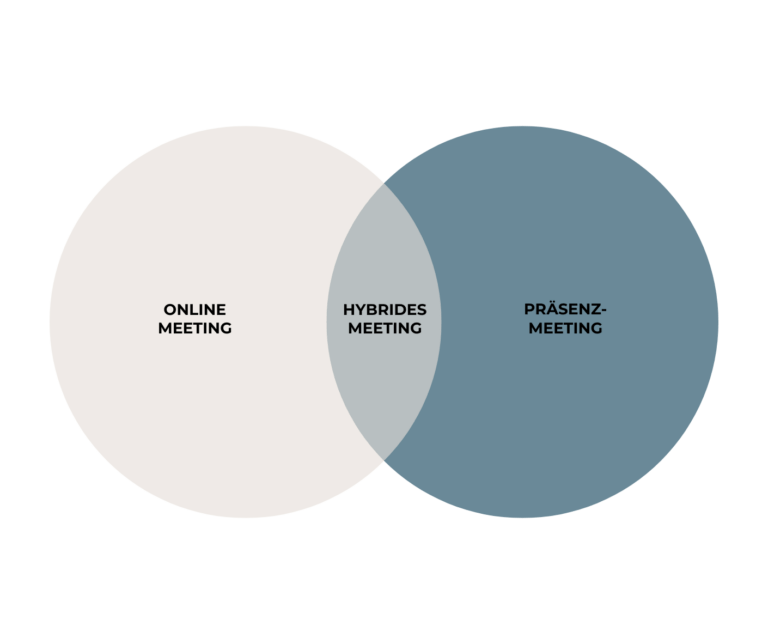
Effective meeting management is a topic that has been massively on the minds of many of us for the past two years. There's no question in my mind that there are too many of them. In the digital world of work, what are the options for conducting a meeting and making it efficient? What are the advantages and disadvantages of online, offline and hybrid meetings?
Most meetings have been forced to be held online, especially since the pandemic. Most people have realized that meetings do not have to be held in person, but can be easily planned and conducted online. There are definitely cases where tools such as Zoom or Google Meet are the more efficient solution, even in the future. But are they always?
Everything from the beginning: face-to-face meetings
Face-to-face meetings were the standard in most companies before the pandemic. After legal and company home office regulations, many wanted to go back to that, in order to finally have all employees together and at work again. But this is undeniably the wrong approach, because the world of work is constantly changing and developing. Sometimes, however, an exchange in person makes perfect sense. What are the arguments in favor of an on-site meeting in the future? And what are the arguments against it?
Facial expressions & gestures create emotions
The biggest advantage is the wide range of natural forms of communication. Non-verbal communication plays a decisive role for us in being able to correctly assess people and situations. Gestures, posture, attention, tonality - all these phenomena are much easier for our brain to process than digital videos and images. It is much more complex to encounter other people via screens than to have them directly in front of our eyes. Interpersonal interactions and emotions are much more difficult for us to recognize and evaluate digitally at this point in time.
Also, a meeting in presence pays off in relationships. When many people come together in a real space, a much more organic, natural and human situation is created than in a virtual space. A shared coffee, a quick chat on the way to the restroom, a private exchange during a break, or a nice smile connect and create emotions.
Meeting management: Complex and inflexible?
It all sounds wonderful! So everything back to square one and all men and women back in the conference room? Not quite. Because face-to-face meetings also have disadvantages. They are usually inefficient because they require a lot of resources - be it rooms or travel. In an international context, this means an incredible number of flights, which in turn means a lot of time spent on a meeting. There is usually more logistical effort behind an offline meeting and this often means that we are pulled out of our workflow more than if we just join a meeting online.
Being tied to a specific location is also a disadvantage. This does not allow for short notice or flexibility. Full participation is almost impossible due to illness, business trips or outsourced offices.

Curse and blessing: online meetings
At the beginning of the pandemic, when all employees were relegated to the home office, online meetings were an exciting thing. But after the first few weeks, disillusionment, if not aversion, spread, at least in my environment. Inefficient meetings, inattentive participants and technical problems prompted the question: Can't we go back to the office? What are the pros and cons of online meetings?
Flexibility in a global working world
Digital meetings are resource-efficient, especially in an international context. No one has to get on a plane or travel half a day to attend a meeting. For cross-functional teams that are spread all over the world, the meeting form brings many benefits. In addition, meetings can be scheduled and held more flexibly and spontaneously. It's easier to get together at short notice on the computer screen than to meet in the office.
Most online meetings in the form in which they take place today are certainly not particularly well suited to building or maintaining relationships. In most cases, interpersonal aspects are neglected. However, this is less due to the tools than to the way we use them. Digital tools for meeting management are not so unsuitable for strengthening interpersonal contacts. We simply haven't yet learned how this works in a digital world.
Digital and emotional: creating signals
Important nuances are often lost in online communication. Statistically, people are less confident about contributing online than they are in person. As a moderator, you have less opportunity to recognize who wants to interact. In the conference room, this can be signaled very subtly through body posture, eye contact, raising hands: I want to say something. In an online meeting, the meeting flow has to be interrupted a lot and the inhibition threshold is simply higher. The non-verbal signal level is missing. Although there are now numerous functions, such as raising hands or even chat, that enable such a signal level, it has to be learned. And this does not mean the click of a button. Digital communication is a whole new world that requires a new communication style. We have to learn this language.

Digital Workplace: Hybrid Meetings
Hybrid meetings are simply a hybrid of the latter two. This means that participants take part online as well as offline from different locations (office, home office, mobile workplace).
Meeting management challenges
Hybrid meetings often have an insanely bad reputation because the technology behind them unfortunately still seems complex for many companies. And to some extent it is. After all, it requires a new kind of sound and image management, and equipment to go with it. For example, it is not possible to work only with the sound of the presenter(s), because as soon as an exchange takes place, it is no longer audible to all online participants. A moderator can compensate for this by repeating the core message or the question, but this requires a lot of experience for professional implementation. Technology and room equipment are definitely still a major challenge when it comes to hybrid meetings.
"Oh, you're still here!"
Proximity bias also (still) speaks against hybrid meetings. People always prefer the participants who are physically closer. They are more likely to let them have their say and their opinion weighs more than the opinion of a small head on a screen. This phenomenon favors a two-class meeting.
In view of the rapid changes in the world of work, these disadvantages must be seen as challenges and not as counterarguments. Meetings will increasingly be held hybrid in the future, which is an optimal way to promote flexible and location-independent working. We must therefore learn to manage the corresponding technology and to equate our perception of virtual and real situations.
What will meeting management of the future look like?
All three forms of meetings will continue to exist in the future. We need to become masters in all three forms and in meeting management, because there is plenty of room for improvement in all of them. Companies need to realize that efficiency is lost in meetings as we hold them today. In my opinion, the most important question is not the question of the meeting form, but the question: How can we schedule fewer meetings? Because we are in the middle of a focus crisis. Employees need more space for focused work. A meeting here, a meeting there - they interrupt important workflows. By the way, the focus crisis is also one of the Top 10 New Work Trends for 2023, which you can read about here.
